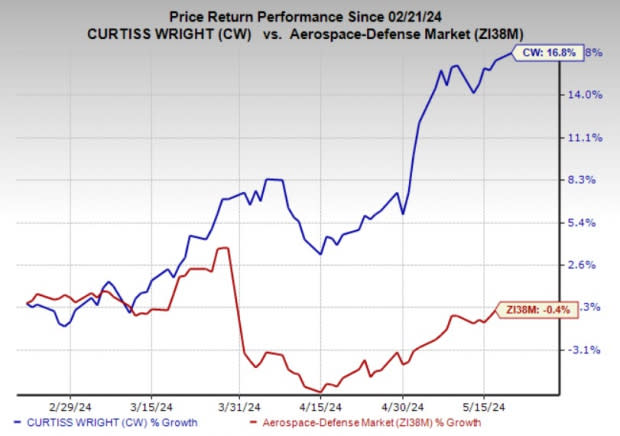Curtiss-Wright (CW) Secures a Contract for Tactical Networking
Curtiss-Wright Corporation CW recently clinched a $16 million contract from Iron Bow to offer the United States Air Force (“USAF”) a comprehensive solution for optimizing and improving deployable communications. The work related to this contract will be performed through 2027.
About the Contract
Per the terms of the contract, Curtiss-Wright will supply the USAF with its PacStar 400 series modules and Commercial Solutions for Classified (CSfC) integration. The estimated lifetime value of the contract is more than $60 million.
Furthermore, by using software automation, Curtiss-Wright's CSfc solution will improve network security and connectivity for a variety of classification levels.
Growth Prospects
Amid growing geopolitical tensions and warfare situations worldwide, successful military operations heavily rely on the ability to exchange information across the battlefield safely and securely, which is considered the most crucial factor. As nations are rapidly expanding their investments in Military Communication, the availability of fast and reliable communication networks to connect the operational base and fighters on the air has emerged as the need of the hour.
Consequently, as defense sectors across the board are focusing more on making their digital communications faster and more secure, defense contractors like Curtiss-Wright are witnessing solid contract flows involving the strengthening of its Tactical Networking Technology capabilities. The latest contract win is a bright example of that.
Therefore, the Military Communication market’s prospects remain robust due to growth in asymmetric threat environments and the evolving nature of warfare. To this end, per a report by Mordor Intelligence, the Defense Communication market is projected to witness a CAGR of 5.86% during the 2024-2029 period.
Such a solid market prediction offers strong growth opportunities to Curtiss-Wright, which boasts the capability of delivering Encrypted Tactical Networking Communication services as threat actors adopt new tactics and techniques. Its CSfc product is an important part of NSA’s commercial cybersecurity strategy, which delivers secure solutions that leverage commercial technologies and products to deliver cybersecurity solutions quickly.
Meanwhile, CW’s PacStar 400-Series line of deployable communications hardware delivers enterprise-class functionality in a rugged, small form factor designed using a customer-centric approach for use in small team, ground, vehicle-based and command-post applications. With the latest contract win, we may expect to witness a significant deployment of Curtiss-Wright's PacStar product line for the U.S. Air Force.
Peer Prospects
Apart from Curtiss-Wright, defense contractors that are anticipated to benefit from the expanding Military Communication spending market are as follows:
Northrop Grumman NOC: The company delivers secure, protected and survivable communications to help U.S. military services achieve information superiority.
For safe, jam-resistant, tactical and strategic communications for military tactical and strategic forces, NOC’s Enhanced Polar System offers constant coverage in the polar zone, which represents an evolution of requirements for protected, extremely high-frequency satellite communications in the North Polar Region.
Northrop has a long-term (three to five years) earnings growth rate of 9.9%. The Zacks Consensus Estimate for NOC’s 2024 sales suggests growth of 4.6% from the prior-year reported figure.
General Dynamics Corporation GD: This company is another notable provider of tactical communication systems. GD’s Digital Modular Radio (“DMR”) is the first software-defined radio to be adopted as a communications system standard by the U.S. military. It is one of the Navy's most adaptable tactical radio systems that can support both voice and data satellite communication networks. The DMR is currently deployed on 12 different U.S. ships and submarine platforms.
General Dynamics has a long-term earnings growth rate of 11%. The Zacks Consensus Estimate for GD’s 2024 sales implies growth of 10.5% from the prior-year reported figure.
BAE Systems BAESY: The company develops radio frequency communications, datalinks and flight control systems for the upcoming generation of military aircraft.
Its Network Tactical Common Data Link enables the exchange of command-and-control information across separate or independent networks, as well as the simultaneous transmission and reception of real-time intelligence, surveillance and reconnaissance (ISR) data from multiple sources by U.S. Navy personnel.
BAESY has a long-term earnings growth rate of 12.2%. The Zacks Consensus Estimate for the company’s 2024 sales calls for growth of 34.1% from the prior-year reported figure.
Price Movement
In the past three months, shares of Curtiss-Wright have risen 16.8% against the industry’s decline of 0.4%.

Image Source: Zacks Investment Research
Zacks Rank
Curtiss-Wright currently carries a Zacks Rank #2 (Buy). You can see the complete list of today’s Zacks #1 Rank (Strong Buy) stocks here.
Want the latest recommendations from Zacks Investment Research? Today, you can download 7 Best Stocks for the Next 30 Days. Click to get this free report
Northrop Grumman Corporation (NOC) : Free Stock Analysis Report
General Dynamics Corporation (GD) : Free Stock Analysis Report
Bae Systems PLC (BAESY) : Free Stock Analysis Report
Curtiss-Wright Corporation (CW) : Free Stock Analysis Report

 Yahoo Finance
Yahoo Finance 